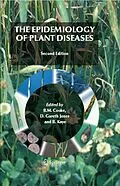Plant disease epidemiology is a dynamic science that forms an essential part of the study of plant pathology. This book brings together a team of 35 international experts. Each chapter deals with an essential component of the subject and allows the reader to fully understand how each exerts its influence on the progress of pathogen populations in plant populations over a defined time scale. Since the first edition of the text was published in 1998, many new developments have occurred in the subjects covered, particularly molecular diagnostics, modelling, fungicide resistance and information technology. The second edition of the book is a comprehensive text on all aspects of plant disease epidemiology that should serve as an invaluable reference work for those involved in this fascinating science of crop plants.
Autorentext
B.M. Cooke is a Professor of Plant Pathology and the Editor-in-Chief of the European Journal of Plant Pathology at the School of Biology and Environmental Science, University College Dublin, Ireland.
D. Gareth Jones is an Emeritus Research Professor of the Welsh Institute of Rural Studies, Aberystwyth, Wales, UK.
Bernard Kaye is a multi-media consultant in the School of Biology and Environmental Science, University College Dublin, Ireland.
Inhalt
Contributors. Preface. Part 1: Principles and Methods. 1. Plant disease diagnosis; R.T.V. Fox, H.P. Narra. 1.1 Introduction. 1.2 Choice of diagnostic. 1.3 Diagnosis by conventional techniques. 1.4 Use of immunological reactions. 1.5 Methods based on the nucleic acids of pathogens. 1.6 Future trends in diagnosis. References. 2. Disease assessment and yield loss; B.M. Cooke. 2.1 Introduction. 2.2 Why assess disease and yield loss in plants? 2.3 Methods used in sampling plants for disease. 2.4 Timing and frequency of disease assessment. 2.5 Methods of disease assessment. 2.6 Assessment of yield loss. 2.7 Conclusions and future developments. References. 3. Surveys of variation in virulence and fungicide resistance and their application to disease control; J.K.M. Brown. 3.1 Introduction. 3.2 Characterizing individual pathogens. 3.3 Populations and samples. 3.4 Molecular detection of virulence and fungicide resistance. 3.5 Characterizing pathogen populations. 3.6 Applications of pathogen survey data. 3.7 Dissemination of survey results. 3.8 Pathogen surveys and disease management. Acknowledgement. References. 4. Infection strategies of plant parasitic fungi; C. Struck. 4.1 Introduction. 4.2 The pre-penetration phase. 4.3 Entering the plant tissue. 4.4 Strategies for colonizing the host tissue. 4.5 Concluding remarks. References. 5. Epidemiological consequences of plant disease resistance; M.L. Deadman. 5.1 Introduction. 5.2 Horizontal resistance. 5.3 Vertical resistance. 5.4 Cultivar mixtures. 5.5 Induces resistance. 5.6 Non-host immunity. 5.7 Tolerance. References. 6. Dispersal of foliar plant pathogens: mechanisms, gradients and spatial patterns; H.A. McCartney et al. 6.1 Introduction 6.2 Underlying mechanisms: spore dispersal. 6.3 Spore deposition and disease gradients. 6.4 Disease spread: modeling developments of foci. 6.5 Conclusions. Acknowledgements. References. 7. Pathogen population dynamics; M.W. Shaw. 7.1 Introduction. 7.2 The measurement of populations. 7.3 Time-scales. 7.4 Changes in population. 7.5 Density-dependent and density-independent factors. 7.6 Short-term change in a static host population. 7.7 Affected host tissue and pathogen multiply at comparable rates. 7.8 Changes over time-scales longer than either crop or pathogen. 7.9 Spatial population structure. Appendix 7A. References. 8. Modelling and interpreting disease progress in time; X. Xu. 8.1 Introduction. 8.2 General considerations. 8.3 Analysing individual epidemics. 8.4 Reducing data dimension. 8.5 Comparing epidemics. 8.6 Concluding remarks. References. 9. Disease forecasting; N.V. Hardwick. 9.1 Introduction. 9.2 What is forecasting? 9.3 Polycyclic and monocyclic diseases. 9.4 Equipment. 9.5 Forecasting schemes. 9.6 Potatoes. 9.7 Cereals. 9.8 Oilseed rape. 9.9 Conclusions. References. 10. Diversification strategies; M.R. Finckh, M. Wolfe. 10.1 Introduction. 10.2 Definitions. 10.3 Benefits from spatial diversification: small-scale. 10.4 Benefits of diversification in time (crop rotation). 10.5 Diversity and interactions. 10.6 Responses of pest and pathogen populations to diversification strategies. 10.7 Diversification strategies in practice. 10.8 Conclusions. References. 11. Epidemiology in sustainable systems; R.J. Cook, D.J. Yarham. 11.1 Introduction. 11.2 Inoculum. 11.3 Disease development. 11.4 Control strategies. 11.5 Conclusions. Acknowledgement. References. 12. Information technology in plant disease epidemiology; A. Newton et al. 12.1 Introduction. 12.2 Definition of information technology in plant disease epidemiology. 12.3 The world according to 'Google'. 12.4 Real world data capture.
